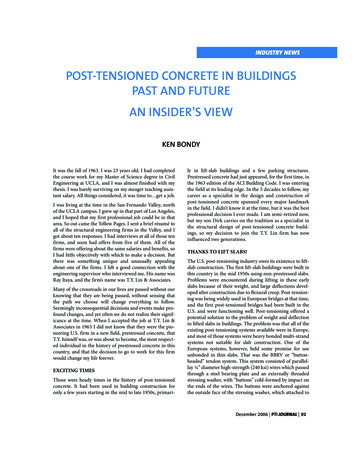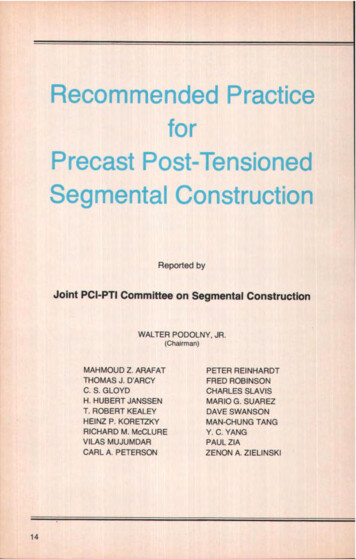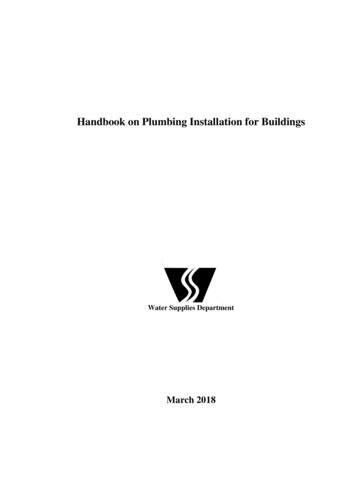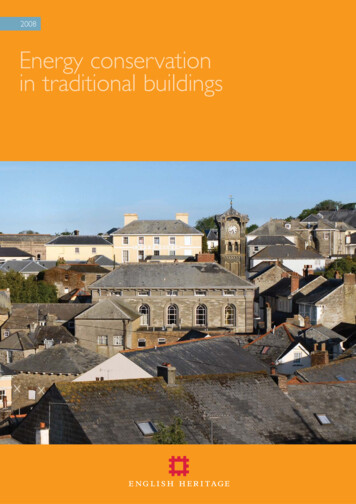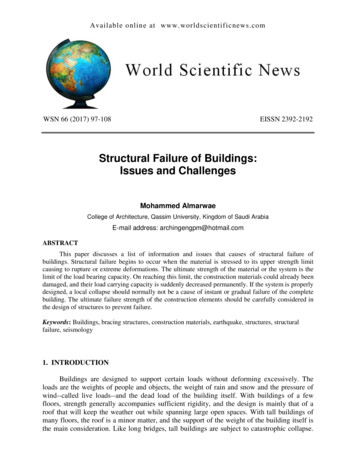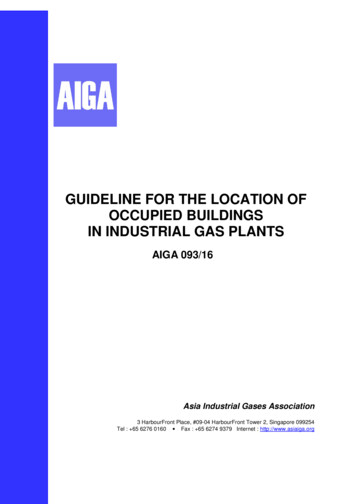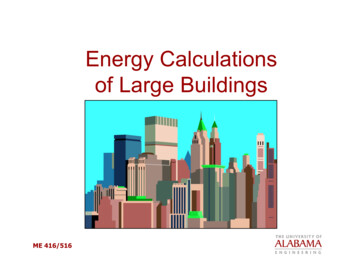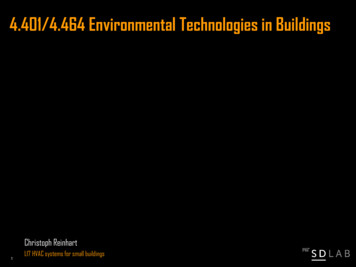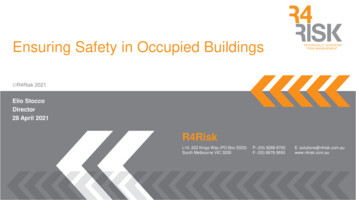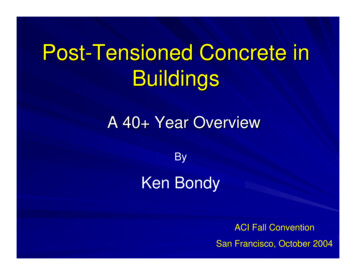
Transcription
Post-Tensioned Concrete inBuildingsA 40 Year OverviewByKen BondyACI Fall ConventionSan Francisco, October 2004
41 Years Ago It was the fall of 1963I was 23 years oldI had completed my MSCE course work atUCLAI was almost finished with my thesisI was being supported by my wife and mymeager Teaching Assistant salaryAll things considered, it was time to .
Get a Job!!!
Out Came the Yellow PagesAny structural firms hiring in the SanFernando Valley?One was, and they hired me!!!Their name was .
T. Y. Lin and Associates
Exciting Time for P/T ConcreteHad been used in buildings for only a fewyears– Mostly in lift-slab constructionPrestressed concrete had just beenintroduced into ACI Building Code (1963)for first timeIn the next 41 years my career spannedevery major landmark in the developmentof p/t concrete in buildings
Thanks to Lift-Slabs!!US post-tensioning industry owes itsexistence to lift-slab constructionFirst lift-slab buildings in the US were builtin the mid 1950s using non-prestressedslabsProblems with deflections and slab weightin long 2-way spansTo solve deflection and weight problems,lift-slab companies changed to posttensioned slabs
No Existing U.S. P/T SystemsLift-slab companies went to Europe for helpMost existing hardware was for multistrandtendons in bridgesOnly European system feasible for buildingconstruction was the BBRV “button-headed”tendon systemEach lift-slab company returned with alicense to market the button-headed tendonsystemSome “independent” companies (Prescon,Ryerson, others) also obtained BBRVlicenses.
Button-Headed (BBRV) Anchorage
P/T Solved Deflection ProblemsBut BBRV Tendons Created OthersBoth stressing and dead-end anchorsattached in the factoryRequired exact lengthRequired stressing pockets to cover shimsBulky and expensive couplers whenintermediate stressing required
Strand P/T System Introduced in 1962Developed by Ed Rice (president of T.Y.Lin & Associates)Introduced by Atlas Prestressing Corp.Did not require precise length– Tendons could be cut several feet longer thanconcrete lengthDid not require stressing pocketsDid not require couplers (intermediate“slide-on” anchors)
The First Strand/Wedge AnchorageUsed in the US!
Relied on Tensile Strength ofConcreteMany breakouts occurred, particularly inlightweight concreteAtlas field superintendent (Tom Anderson)suggested chaining anchors togetherLed to award– Recognized Tom’s contributions– Recognized subsequent contributions of otherAtlas employees
TheThomasE.AndersonMemorialAward
Replaced by Ductile Iron Castings in 1963
Integrated Bearing Area with Anchorage
Small,lightweightstressingequipment
Bearing Anchor in UseSOG application(largest US useof p/t)Tendon shownis encapsulated
Strand System vs. Button-HeadSystemAtlas vs everybody else– Prescon– Ryerson– Western Concrete StructuresAfter fierce 5-6 year struggle, Atlas winsbattle of marketplace by late 1960sButton-headed tendons became extinctVirtually all building p/t has been withstrand tendons ever since.
What Happened to Lift-Slabs?Lifting companies combined lifting andtendons in their bids– Excluded independent p/t companies (likeAtlas Prestressing Corp.)Independent p/t companies couldn’t bid onlift-slab jobsWhat did we do .?
Formed Alliances With EmergingFlying Form Industry
Direct CompetitionJoint promotion between p/t companiesand flying form companies allowed directcompetition with lifted buildingsCast-in-place p/t buildings using largepanel flying form systems were highlycompetitive with lifted buildingsBy late 1960s c.i.p. buildings becamepreferred and lift-slab buildings becamerarely used.
Short-Sighted?If lift-slab companies had not originallytried to exclude independent p/tcompaniesLift-slab construction would be asignificant factor in today’s medium-risebuilding market.
Landmarks in P/T BuildingsIntroduction of strand systems– Replaced “button-head” tendon systemDevelopment of ductile iron castings forsingle-strand tendonsIntroduction of “load-balancing” designmethodIntroduction of “banded” tendon layout for2-way slab systemsFormation of Post-Tensioning InstituteImprovements in corrosion resistance
Most Important Single DevelopmentThe introduction of the “load-balancing”design method by T.Y. Lin in 1963T.Y. wasn’t the first to use it but did morethan any other individual to explain it anddisseminate information about it.Made the design of prestressed concreteas easy as the design of non-prestressedconcrete
Promotion of P/T in BuildingsAtlas Prestressing Corp. recognized in mid1960s that the most effective way toincrease the market for p/t was to teach engineers how to design it and to assist them in their designsWith this marketing philosophy, Atlas grewfrom smallest to largest p/t firm in lessthan ten years.
SeminarsAtlas sponsored over 100 one-day designseminars between 1965 and 1976Held in most major US cities and inwestern EuropeAttended by more than 2000 practicingengineersOften resulted in p/t building within 6months of seminar
Building CodesPost-tensioning virtually absent from ACI318-71 (“ignore secondary moments”)ACI 318-77 and 83 were greatly improved– Reflected testing at Texas and Washington– Banded tendon distribution– Minimum bonded reinforcement requirements– More attention to indeterminate structuresCodes have continued to improve withmore p/t expertise on ACI committees
Formation of PTIPost-tensioning was represented as adivision within PCI in late 1960s throughmid 1970sPTI formed as an independent institute in1976PTI gives contractors and engineers asingle unified source and voice for p/tdesign and construction informationEstablishes a standard of care in manyareas of design and construction
Construction AdvancesHigh-rise construction in HawaiiBanded tendons in 2-way p/t slabs
Honolulu Skyline circa 1977
Wall Jump-Forms and Flying Deck Forms
Slabs Hung From Walls
3 Days per FloorPlace slab concrete on Monday morning– Walls and columns are two lifts aboveStress tendons on Tuesday morning– Oversize anchors (4x6) to permit stressing at1,500 psi – achieved in 24 hoursFly forms on Tuesday afternoonInstall tendons and rebar on Wednesday– Placed through sleeves in walls and columnsPlace slab concrete on Thursday morning
Banded Tendons in 2-Way SlabsFirst used in the most famous posttensioned concrete building ever built
TheWatergateApartmentsinWashington,D.C.
Basket-Weave Tendon Layout for2-Way SlabsSome in “column-strips”Some in “middle strips”Tendons were “draped” in curved verticalprofile– High at column lines– Low at midspansA single tendon profile had someorthogonal tendons above it and somebelow it
Some Above, Some Below #3#1#2#1
SequencingDetailer had to find the single tendonwhich was below all other tendons– Sequence #1Then had to find tendon in perpendiculardirection which was below all remainingtendons– Sequence #2Typical slab would have 30-40 sequencenumbers
Tendons Had to be Installed inSequenceAny errors in placing sequence resulted in“birds-nest” when chaired
Back to Watergate In the Watergate building, columns didn’tline up in either directionSpans were short (22’ max) but columswere located where they could be hiddenwith no regard to a grid systemColumn/middle strip concept meaninglessLoad path virtually impossible to follow
Slab Design Engineers(T.Y. Lin and Atlas Prestressing Corp.)Conceived the load path as a one-wayslabDeveloped a tendon layout where all of thetendons in one direction were placed in anarrow “bent” band connecting columnsAll of the tendons in the orthogonaldirection were uniformly distributed.Load path was easy to follow, like in aone-way beam and slab system
It Worked!And it resulted in a significant savings inlabor costs– Eliminated tendon sequencing– All band tendons installed first– All uniform tendons installed nextHas become standard method for tendonlayout in 2-way slabs– Hundreds of millions of square feet in service– Behavior studied and verified in numerouslaboratory tests
4-Panel Test at University of Texas
SimpleLightTendonLayout
Notice Anything Unusual?
SimpleButHeavyTendonLayout
Complicated Tendon Layout
ProblemsRestraint-to-shortening– Mechanics of RTS different in prestressedand non-prestressed members– Engineers had to learn how to design p/t floorsystems with levels of cracking normallyaccepted in non-prestressed floor systems– MethodsJoinery detailsNon-prestressed reinforcement
Biggest ProblemTendon Corrosion– Early sheathing and grease were inadequatefor aggressive corrosion environmentsMaterial specifications developed by PTIhave largely solved early corrosionproblems– Improvements in sheathing material, coatings,complete encapsulation
The FutureStrengthening existing buildings withexternally applied p/t tendonsTall concrete buildings
Strengthening With External PostTensioning
Loads
One-Way Slabs
Beams and Girders
2-Way Slabs
Orthogonal Trusses
Two-Way Slab with Load at Mid-Panel
Fireproofing
Fireproofing Options
10-Story Building Strengthened FromBelow First Floor
Tall BuildingsP/T reduces weight of floor systemsHigh-strength concrete makes columnsizes reasonableAdvantages– CostExposed exterior frame beams and columns– Fire and blast resistance– Sound and vibration
3900AlamedaBurbank,CATallest ConcreteBuilding EverBuilt in SeismicZone 4 (at time ofconstruction –late 1980s)
Thank You!!
Thanks to Lift-Slabs!! US post-tensioning industry owes its existence to lift-slab construction First lift-slab buildings in the US were built in the mid 1950s using non-prestressed slabs Problems with deflections and slab weight in long 2-way spans To solve deflection and weight problems, lift-slab companies changed to post-tensioned slabs
